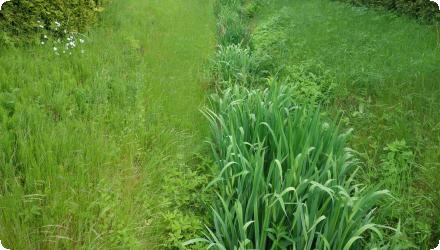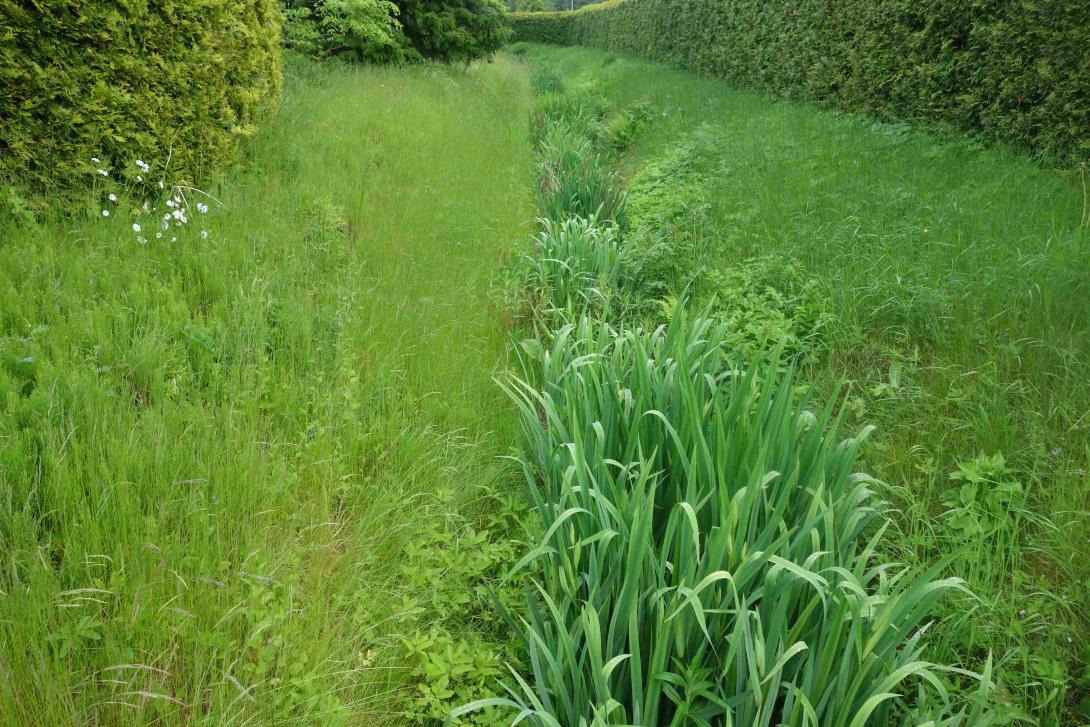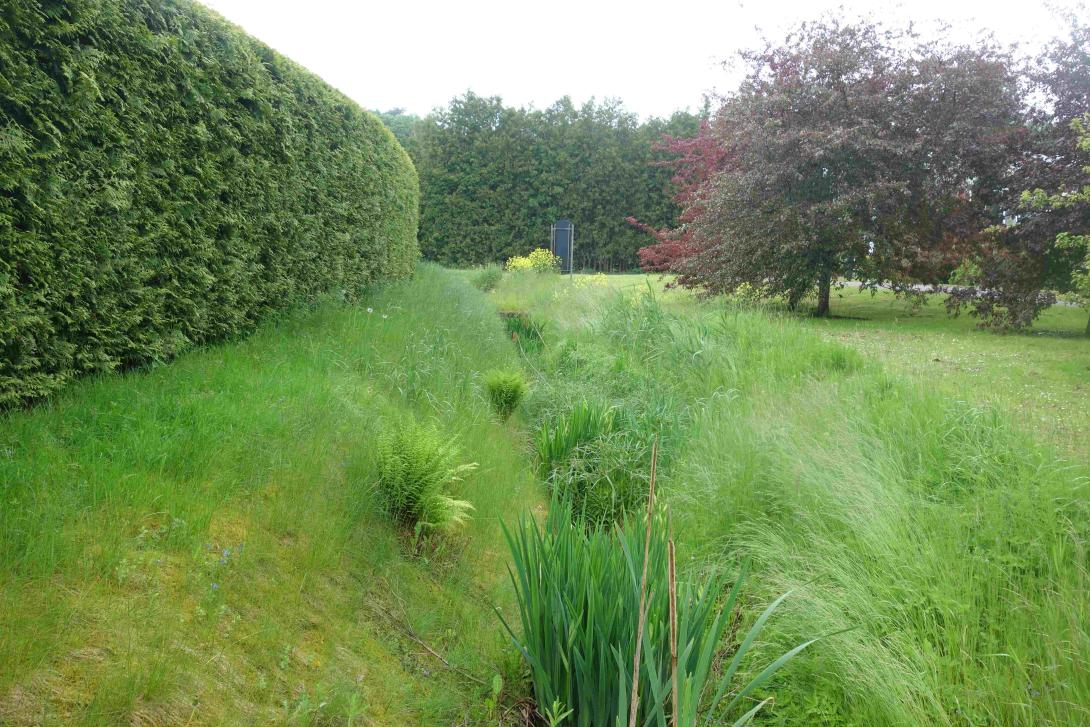Last update
2025
Summary
Reconstruction of the Lepiku channel that is a part of the drainage system, which starts from the new residential area next to the Tallinn Botanic Garden and includes wetlands, detention ponds, ditches and channels and debouches into Pirita river. The aim was to improve the quality of the storm water that flows into the Pirita river. The river Pirita is a part of Natura 2000 site and flows into the Baltic Sea. The length of the reconstructed channel part is ca 195 m and the works included: widening of channel bottom in different segments, creating artificial dykes and rapids and creating suitable conditions to the aquatic plants exhibits in Botanic Garden.
Position
Latitude
59.4822
Longitude
24.8764
Project
NWRM
National Id
Estonia_03
Installation date
2015
Implementation Status
RBD code
EE1
Transboundary
0
Photo gallery
Location of the project
Near Kloostrimetsa Road, Tallinn, Estonia. Near Palmhouse of Tallinn Botanic Garden.
NUTS Code
EE00 - Eesti
Project's objectives
1. The aim was to improve the quality of the stormwater that flows into the Pirita river
2. Pollutants Removal – to create a natural purification process in order to decrease the quantities of particles in the water
3. To show citizens privileges of a watercourse – water elements diversify nature and bring recreational values
2. Pollutants Removal – to create a natural purification process in order to decrease the quantities of particles in the water
3. To show citizens privileges of a watercourse – water elements diversify nature and bring recreational values
Involved Partners
| Authority type | Authority name | Role | Comments |
|---|---|---|---|
Climate zone
cool temperate moist
Temperature
6.5
Precipitation
695
Annual rainfall range
600 - 900 mm
Runoff
0,3–0,4 m3/s
Elevation range
30
Vegetation class
Cultural landscape (botanic garden area where near the channel are different plants)
Water bodies: Ecological Status
Good
Water bodies: Chemical Status
Failing to achieve good
Water quality status
Pollution from surrounding housing area
Project scale
Micro
Project scale specification
Regional, metropolitan and urban level
Performance timescale
1 - 4 years
Project area
200 m
Size
195
Size unit
m
Lifespan
Until 2050
Local plants cleaning the water
Ensuring the slopes of the channel; to create a natural purification process in order to decrease the quantities of particles in the water.
The aim for Tallinn Botancal Garden was reorganisation of the channel section. And not just cleaning the channel and ensuring banks but while doing it to keep in mind water purification, water regime regulation and aesthetic appearance. Aim was to design a modern, eco-friendly and not very costly solution, which would set a good example for the other channels and trenches in Tallinn. Maybe to change the the way of thinking to solve the problem through hiding water into the pipe underground instead bringing it visuable in the channel on the ground.
Total cost
114 595 €
Costs total information
Usaually LIFE+ cofinancing is 50% but in agreement the share was raised based on the co-financing of Finnish MoE to 84,91% which left to City of Tallinn co-financing share of 15,09 %
Costs investment
35000
Costs investment information
Reconstruction works including materials and designn
Financing authorities
Type of funding
EU-funds: LIFE+
Comments
LIFE+ project “Benchmarking water protection in cities – CITYWATER” (LIFE 11 ENV/FI/000909)
Type of funding
Local funds
Compensations
0
Policy context
There are in total 9 ponds in the territory of Tallinn Botanic Garden, some of them feed on springs and the water collected in the Botanic Garden´s territory but most of the water is coming from Lepiku channel (catchment 150,4 ha). Most of the ponds were built in 1963-1965 on channels that existed before. The Lepiku channel that is feeding the ponds of Botanic Garden has not been cleaned for years. Additionally the channel is partly closed to pipes which hinder water runoff and self-cleaning of water. The ponds have been cleaned and the banks been fixed depending on financial possibilities.
In last ten years it was noticed that in the years that were warmer and had less precipitation the water started to “bloom” – satiated with different algae and aquatic plants were proliferating which refers to nitrogen and phosphorus compounds’ inflow from Lepiku channel catchment where a lot of new buildings have been built. It is also possible that the bottom of one pond is polluted by fuel oil that that was flowing in there from a boiler house that was situated in the bank of the pond in 1980s.
That meant that excessive amount of suspended solids, nitrogen and phosphorus compounds and possibly oil products end up in the gulf of Finland that is 2,5 km away via Pirita river.
In last ten years it was noticed that in the years that were warmer and had less precipitation the water started to “bloom” – satiated with different algae and aquatic plants were proliferating which refers to nitrogen and phosphorus compounds’ inflow from Lepiku channel catchment where a lot of new buildings have been built. It is also possible that the bottom of one pond is polluted by fuel oil that that was flowing in there from a boiler house that was situated in the bank of the pond in 1980s.
That meant that excessive amount of suspended solids, nitrogen and phosphorus compounds and possibly oil products end up in the gulf of Finland that is 2,5 km away via Pirita river.
Land ownership
Tallinn city
Community involvment
No
Design consultation activity
| Activity stage | Name | Key issues | Comments |
|---|
Policy target
| Target purpose |
|---|
|
Pollutants Removal
|
Target Remarks
Reduce nutrition flow to the salmon river Pirita
Policy pressure
| Pressure directive | Relevant pressure |
|---|
Policy impact
| Impact directive | Relevant impact |
|---|
Requirement directive
| Requirement directive | Specification |
|---|
Contractual arrangements
0
| Arrangement type | Responsibility | Role | Name | Comments |
|---|
Part of wider plan
1
Wider plan type
| Wider plan type | Wider plan focus | Name | Comments |
|---|---|---|---|
|
Local
|
Water
|
Development plan of Tallinn 2009-2027
|
5th main objective: citizen of Tallinn connecting sustainably home, work and rest – Tallinn with cosy, inspiring and environmentally sustainable urban space,
5.4 Technical infrastructure services are of high quality, available for residents of the city and meet the safety and environmental protection requirements Measure 2: guaranteeing channelling of storm and surface water |
|
Local
|
Water
|
Tallinn Environmental Strategy 2030
|
Point 2.3.1.3.(Coastal waters) states that the aim is to restore the ecological balance in marine environment and guaranteediversity of nature and achieve in necessary water quality in the recreational areas.
Point 2.3.2 (rain water) emphasizes the need to work out concept for rain/storm water removal. |
|
Local
|
Water
|
Tallinn public water supply and sewerage development plan 2010-2021
|
Point 10 (storm water systems) maps the bottlenecks related to storm water removal, including the degrading impact of water flowing in from the urban region to the status of Tallinn Botanic Garden ponds both in quantitative and qualitative way, which in turn degrades the quality of storm water flowing in Pirita river
|
|
Local
|
Water
|
Tallinn stormwater strategy to 2030
|
Point 3.2.11 (new catchments) foresees the development of Lepiku-Laiaküla catchment as the area needs researches and development of holistic solution in order to guarantee storm water removal and good status of Tallinn Botanic Garden ponds.
Point 6.1 sets the strategic aim to achieve ecological status of storm water recipients (coastal sea and inland water bodies of Tallinn) and continuous improving of the storm water quality that flows in the recipient water bodies. |
Monitored will be in future water quality (N, P etc)
Maintenance
Tallinn Botanic Garden, annually : plantation of the channel and removal of extra plants when they hinder the water flow. Mowing in autumns.
Catchment outlet
Increased appreciation for natural spaces, Increased knowledge of locals about local nature, Increased awareness of NBS and their benefits.
Reconstruction and cleaning of the Lepiku channel means that cleaner water will flow in to the Botanic Garden’s ponds and later in Pirita river and in the Gulf of Finland – this way improving the ecological status of water. The project has reduced the maintenance necessity to clean nearby pond of the rose garden.
The reconstruction of the Lepiku channel on the territory of Tallinn Botanic Garden may be handled as a pilot project, the objective of which is to raise awareness of the residents of the area. In the lower course of the reconstructed ditch the self-cleaning system should be more effective than in the straight, piped upper course, as is the case at the moment in the upper course. The innovation, by most part, lies in the fact that with very simple means and relatively low cost it is possible to build a self-cleaning, aesthetically enjoyable rainwater handling solution. The solution will help the residents of the drainage area to understand the need the importance of water conservation and offers inspiration to land owners whose land the ditch passes through, and hopefully helps them to understand that an attractively and effectively built ditch will increase the value of their land, rather than be a possible area for problems.
Information on Water quality overall improvements
In last ten years it was noticed that in the years that were warmer and had less precipitation the water started to “bloom” – satiated with different algae and aquatic plants were proliferating which refers to nitrogen and phosphorus inflow from Lepiku channel catchment where a lot of new buildings have been built. It is also possible that the bottom of one pond is polluted by fuel oil that that was flowing in there from a boiler house that was situated in the bank of the pond in 1980s.
That meant that excessive amount of suspended solids, nitrogen and phosphorus compounds and possibly oil products end up in the gulf of Finland that is 2,5 km away via Pirita river. Reconstruction and cleaning of the Lepiku channel means that cleaner water will flow in to the Botanic Garden’ s ponds and later in Pirita river and in the Gulf of Finland – this way improving the ecological status of water. As works are not yet finalised then chane cannot be estimated.
That meant that excessive amount of suspended solids, nitrogen and phosphorus compounds and possibly oil products end up in the gulf of Finland that is 2,5 km away via Pirita river. Reconstruction and cleaning of the Lepiku channel means that cleaner water will flow in to the Botanic Garden’ s ponds and later in Pirita river and in the Gulf of Finland – this way improving the ecological status of water. As works are not yet finalised then chane cannot be estimated.
0
Spreading of slugs (Arion vulgaris)
Ecosystem impact climate regulation
No information available
Key lessons
Limestone walls worked well as also the selected plants, except Typha latifolia, which was too big for this small channel
Success factor(s)
| Success factor type | Success factor role | Comments | Order |
|---|---|---|---|
|
Financing possibilities
|
main factor
|
<p>measeure was implemented in frame of the LIFE+ project “Benchmarking water protection in cities – CITYWATER” (LIFE 11 ENV/FI/000909)</p>
|
1
|
|
Legal obligations
|
secondary factor
|
<p>Achieving good ecological quality of waters by 2015 (WFD)</p>
|
2
|
|
Other
|
main factor
|
<p>The success of the project can be evaluated on two levels. The first is the population, land owners and the government's awareness. The project has justified itself when in the Lepiku channel upper course rainwater is handled by using local solutions rather than just leading the water into a sewerage. The second positive aspect of the project is the quality of water that runs from the Lepingu water course into Pirita river. It is assumed that in the reconstructed area of the ditch, the self-cleaning system is quite effective. However, to prove this, it will be necessary to monitor the area. Monitoring will commence right after the ending of reconstruction.</p>
|
3
|
Driver
| Driver type | Driver role | Comments | Order |
|---|---|---|---|
|
Legal obligations
|
main driver
|
Achieving good ecological quality of waters by 2015 (WFD)
|
1
|
|
main driver
|
Availability of funds - measeure was implemented in frame of the LIFE+ project “Benchmarking water protection in cities – CITYWATER” (LIFE 11 ENV/FI/000909)
|
2
|
Transferability
Easily transferable, in large extent in urban areas.
English



